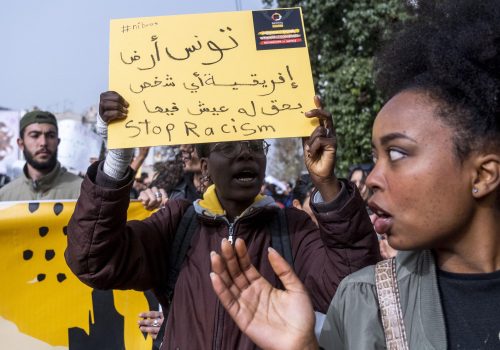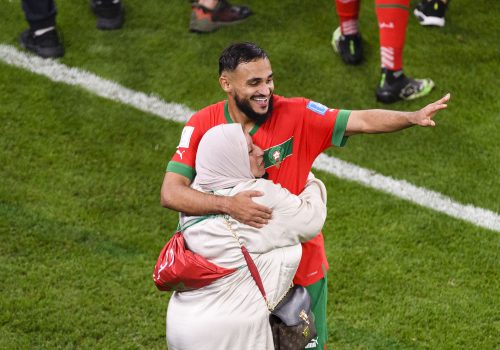A war is raging between Algeria and Morocco. It is being fought in the heritage arena.
While strolling the labyrinth of Algiers’s ancient alleyways in 2014, I encountered a rare copper artisan in the casbah. As I took photos of his tiny shop, he glanced at me suspiciously. Once he learned I was Moroccan, he warmly welcomed me with mint tea, nostalgically recalling Si Mohamed, the master artisan from Fez who taught him the craft in the 1960s. Had I met this artisan today, amid the extremely polarizing cultural heritage competition between Morocco and Algeria, he would surely be more reserved about his apprenticeship and ties to the neighboring country.
As political tensions between Algiers and Rabat have continued to mount since 2020, threatening to destabilize the entire North African and Sahel region, another front is being fought with no possible détente in sight: the cultural heritage war. The most recent chapter of this absurd dispute began when the Moroccan Ministry of Culture took legal action on May 20 by filing a complaint against Algeria with the United Nations Educational, Scientific and Cultural Organization (UNESCO) for the alleged appropriation of a unique Moroccan traditional garment known as Caftan Ntaâ El Fassi (Ntaâ Kaftan), which came originally from the Moroccan city of Fez and which Algeria is trying to inscribe among its intangible cultural heritage list.
In recent years, there has been a renewed awareness about the significance of cultural heritage symbols and their undisputable value in nation branding. This was popularized, in part, by the Convention for the Safeguarding of the Intangible Cultural Heritage introduced by UNESCO in 2003, which calls for the documentation and preservation of living cultural expressions such as crafts, oral traditions, and performing arts. This phenomenon was also encouraged by the business opportunities presented by cultural tourism, an important source of national wealth that accounts for an estimated 40 percent of all tourism worldwide.
SIGN UP FOR THIS WEEK IN THE MIDEAST NEWSLETTER
Starting in 2008, Morocco and Algeria raced to inscribe diverse aspects of their local traditions with UNESCO. For Morocco, these included the Tbourida equestrian performance, Gnawa music, and the Argan tree and its know-how; for Algeria, they included the pilgrimage to the mausoleum of Sidi ’Abd el-Qader Ben Mohammed, Tlemcen wedding traditions, and the rituals of Sebeiba. However, many cultural elements remain the subject of fierce clashes between the two countries, which compete over the authenticity, exclusivity, and preeminence of disputed cultural symbols like Rai music, the couscous dish, or the Moorish Zellige tile.
The limits of cultural fortresses
Culture is a complex anthropological phenomenon that cannot be confined within the limits of modern nation-state borders—a more recent and contested political invention often inherited from colonial calculus over natural resources. This is particularly true in the case of the Moroccan Kingdom and Algerian Republic’s borders, which were engineered by their former occupiers after the 1845 Treaty of Lalla Maghnia. It is common knowledge by now, as demonstrated by historical maps, archive documents, and an International Court of Justice ruling, that colonial France considered Algeria one of its foreign territories—it annexed Algeria in 1830 and maintained control there until 1962—while Morocco was a mere strategic protectorate with a perpetual Alaouite monarch, which Paris would eventually need to exit with the growing decolonial movements starting in the 1930s. It was evident to France that it was more beneficial for its long-term interests to extract as many territories as possible from the Cherifian kingdom and generously subjoin them to the Ottoman Regency of Algiers.
The impossibility of drawing a line in the sand between two intertwined cultures is the very source of the recent conflict between Rabat and Algiers. Disputed bordering districts like Tlemcen, Tinduf, and Bechar are witnesses of the demographic hybridity and heritage spillover of several forms of craftsmanship, musical expressions, and culinary traditions. For instance, it would be absurd today for Morocco to claim the cultural exclusivity of Malhoun music or for Algeria to claim Rai music—though both are ironically inscribed under one country with UNESCO. This example and many others around the world demonstrate how this United Nations (UN) mechanism, while claiming to preserve cultural heritage, also contributes to the creation of imaginary borders and obsolete disputes among transnational communities that share many affinities, such as the indigenous inhabitants of North Africa.
The concept of cultural authenticity itself is historically questionable. It was established by authors like Eric Hobsbawm in The Invention of Tradition and David Lowenthal in The Past Is a Foreign Country that nation states handle, and often fabricate, historical narratives “celebrating certain aspects and expunging others.” It all depends on what serves their immediate interests, unity, and legitimacy. While Algeria’s oil-economy dependency and introverted military regime delayed its quest to reclaim its heritage, Morocco has benefited from its alignment with Western liberal economies and the urge to develop its tourism and services sectors to tap into its rich traditions and brand itself as an attractive destination at the doors of Europe—often caressing a certain Western orientalist fantasy about the Middle East and North Africa (MENA). Rabat profited from its first-mover status to successfully market its souks, food, and crafts, sometimes exclusively claiming certain shared North African heritage symbols like Amazigh carpets, pottery, and the iconic dish of couscous, though such claims upset its Maghreb neighbors.
Heritage as a unifying juncture
Another recent episode illustrating this cultural heritage battle occurred in 2022, when the sports company Adidas revealed the Algerian soccer team’s jerseys comprising patterns commonly found in Moroccan ceramics, such as Fez Zellige. Morocco responded by issuing a legal warning to the company. The German sportswear brand ended up officially apologizing to Rabat and settling the dispute amicably after admitting to being inspired by Moroccan craftsmanship. Interestingly enough, back in 2015, the kingdom had engaged in patenting the Fez Zellige in the Vienna Classification of Figurative Elements of the World Intellectual Property Organization (WIPO)—a more robust and legally binding mechanism to preserve national crafts compared to the UNESCO treaty. Morocco has since attempted to trademark many more cultural elements, including kaftan embroidery patterns, which closes the loop for anyone trying to “culturally appropriate” Moroccan designs and use them for commercial gains.
Local media, Wikipedia, and social platforms are becoming central fronts in this incongruous cultural war. Both Morocco and Algeria engage restlessly and spend large amounts of money on distasteful online confrontations on YouTube, Facebook, and X (formerly Twitter) debating whether the kaftan is Almohad or Ottoman in origin and if the tajine is an authentic Moroccan or Algerian earthenware pot. Algerian bots, in particular, have been notorious for spreading propaganda and claiming many confirmed Moroccan traditions for themselves. Moroccan social media users carried out an outrageous, yet revealing, social experiment to prove this theory. To make a point, online users jokingly posted that the “Jaghdid” (colloquially meaning poison in Darija) is “a purely Moroccan delicacy,” prompting Algerian users to rush to claim the imaginary dish as theirs.
On the positive side, North African countries are gaining awareness of the importance of documenting and researching their history and memory, leading to a true revival in local crafts, ethnographic research, and a certain pride to showcase and reinvent those ancestral traditions long ignored in favor of Western consumerist goods. Moreover, this awareness contributed to liberating the Maghreb from the shadows of living in the periphery of Middle Eastern capitals like Cairo, Damascus, and Baghdad that repetitively spread false claims that North African countries’ heritage and aesthetic beauty are all to be credited to romanticized and fictitious perceptions of “Arab” Andalucía—a claim that historical evidence strongly refutes.
Last year, “the arts, skills, and practices associated with engraving on metals (gold, silver, and copper)” were inscribed as intangible world heritage by UNESCO in ten MENA countries, including Morocco and Algeria. If the Algerian copper artisan I had encountered and Si Mohamed, the Moroccan one, were to speak today, they would surely approve of this positive collective effort to recognize their craft. The artisans would also agree that while respecting local know-how, originality, and unique historical trajectories is essential, cultural heritage can also be plural and an essential juncture for constructive exchanges beyond trivial political agendas.
Sarah Zaaimi is the deputy director for communications at the Atlantic Council’s Rafik Hariri Center & Middle East programs.
Further reading
Wed, Aug 9, 2023
I spoke to an AI ‘God.’ We chatted about the ethical implications of artificial intelligence in the MENA
MENASource By Sarah Zaaimi
An artificial intelligence “God” is the tip of the iceberg on the ethical implications of AI use in a socially and culturally complex region.
Mon, Mar 6, 2023
Afrocentrism is trending in the Maghreb. It’s because Sub-Saharan migrants are rewriting their narrative.
MENASource By Sarah Zaaimi
North Africa undoubtedly faces a serious migration problem that will continue to aggravate if not addressed regarding its social, cultural, and historical dimensions and root causes.
Wed, Dec 14, 2022
Morocco’s World Cup victories are historical revenge for subaltern dreamers from the global south
MENASource By Sarah Zaaimi
The defeat-free journey of the Moroccan soccer national team, the Atlas Lions, is more than a simple sports score.
Image: 24th edition of the International Crafts Fair, at the Riadh El-Feth esplanade, in Algiers, Algeria on June 23, 2023 with the participation of more than 250 artisans, including around fifty foreigners from several regions in the world (Photo by Billel Bensalem/APP/NurPhoto)



